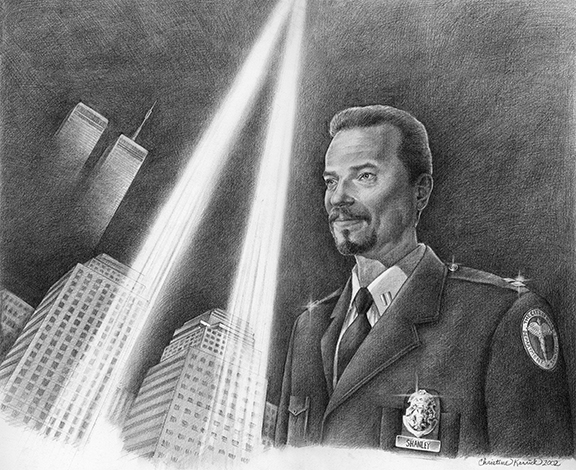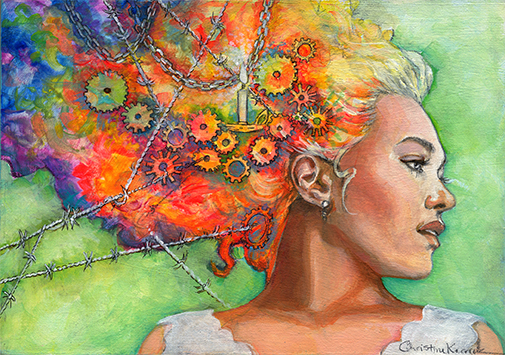
The Call
At Wednesday night service the night after September 11, it was standing room only. The ten-foot distance between the pulpit and the front row was packed with people. Our pastor delivered a timely message, also saying that the numbers of people here tonight would diminish in coming weeks. The shock would wear off and our church, though large, would go back to its normal 800 or so people per service.
I asked later about opportunities to go up and help. Another pastor reassured me there would, and to wait. Floods of first responders from all over the country, press, and of course celebrities, were crowding the area and creating more of a problem. He insisted I not go up there alone. So I did what I always did in stressful situations: I made art.
A friend of mine, a travel agent, told me she had sold Mohammed Atta his plane ticket from Florida to Boston. He was polite, she said, and there was nothing suspicious about him. When the FBI questioned her during their investigation, she told them she felt guilty. They reassured her that if she hadn’t sold the ticket, someone else would have.
Over the following few nights, I had dreams of a darkened New York, and that I was walking over rubble. I came to a brightly-lit crater where huge floodlights illuminated the ruins of what was once the Trade Center. The dust and debris still floated in the black night, and I crept up to the edge of the pit to look over the edge. Every time, I woke up before I saw what was inside.
The Mission
Six months after our country’s worst terrorist attack, a handful of us flew up to New York City to help feed and encourage the workers and law enforcement.
We met with Mary and a few other members of the team already up there. We were the last team from Calvary Chapel, Ft. Lauderdale to serve there. Mary went over ground rules, safety measures, and assigned us shifts. My best friend Vickie and a handful of others would work 10am-4pm in the basement of St. Peter’s Church at Church and Vesey Streets doing food runs, serving hot food to workers, delivering coffee to law enforcement at the perimeter of ‘the pit’—the Trade Center’s deep footprint, and mostly just sitting with someone if they wanted to talk. We were told not to show emotion in the room; to hold our tears in check, or to leave the room if we couldn’t. We would be one of many locations around the scene providing food and comfort as the workers searched for remains, personal effects, and tied back the Hudson River.
The trucks to Fresh Kills Island, which took debris and biohazard away from the site, ran day and night.
The night before we were to start work, our leader Bill took us downtown from our midtown hotel. The subway stopped in front of a mass of earth and rubble at the end of the line, leaving us close to the site. The March cold hit me in the face, but as we climbed up the stairs onto the street, the scene was the same as my dream. This wasn’t the downtown I knew.
Huge floodlights greyed out the black sky behind the last standing buildings before the massive crime scene. Something like fine sand crunched between my teeth. It would be that way all week.
All of us stood at the edge of a fence, seeing the machinery, but not seeing all the way to the bottom of the pit. It was silent there, except for the metallic sounds of work. When remains were found, all work ceased and everyone stood at attention until it was wheeled up a ramp to a containment area.
The remaining buildings were dark and a bit greyer than the white-bright hole over which they sadly stood. Even the construction workers who went up and down out of the scene were quiet.
For the first time since September, I wondered what I could possibly do to help anyone; how I could be an encouragement. What if I cried and had to run out of the church’s basement? I twirled the silver bracelet bearing the name of one of the victims we had received in Florida before the trip. I took a deep breath and followed the others down into St. Pete’s basement to get familiar with everything.
Pews were pushed together to make room for a few long tables with warming trays on them. A local Italian restaurant near Chinatown had been donating meals for the past 6 months. Mary and a few others made runs to and from the restaurant. The back of whoever’s minivan we used looked like the inside of a lasagna.
The next day before our 4pm call time, we walked and rode around the city. Even places further removed from lower Manhattan were quiet. People were different. Little vendor tables selling pictures of the Trade Center and 9-11 paraphenalia had popped up everywhere.
Down at St. Pete’s, we stopped at nearby St. Paul’s Church, which had a fence on either side of it covered with missing persons flyers, flowers, objects of tribute.
My face felt strange all of a sudden. It was twisting into grief. I was about to cry. But I stopped it. I stuffed it. In a few minutes, I had to go in and serve and love on these people. I took a deep breath and went into St. Pete’s basement.
I was going to post some photos of my time up at the Trade Center, but I didn’t want to right now. Maybe sometime, but for now, these few words and accompanying art are what I have. If you want me to post them, let me know in the comments below.
(Part 3 tomorrow)

